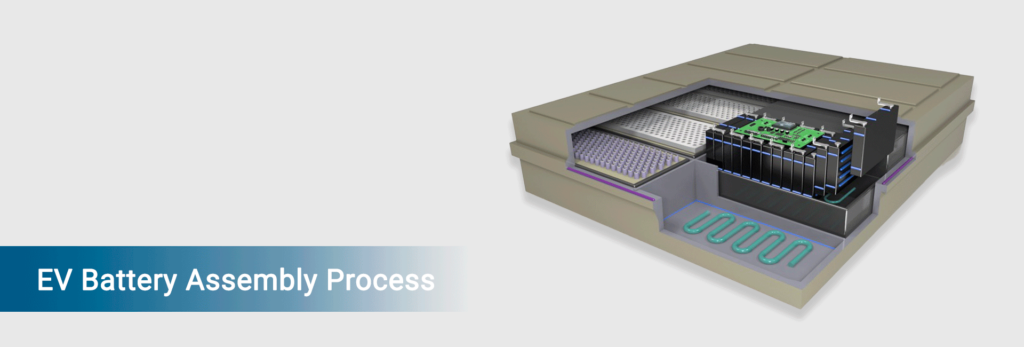The Electric Vehicle Battery assembly process makes sure the battery is ready to use. It involves putting together complex parts with great care. Ensuring each battery cell is precisely aligned and connected is important for creating a functional battery pack. This task requires advanced machinery due to the precision required, as human hands lack the necessary accuracy.
When selecting the method for covering the tray, this precision is a key factor to consider. Additionally, the bonding process must allow for easy removal for maintenance and recycling once the battery reaches the end of its lifespan.
What is the High-Precision Battery Assembly Process?
Automation technology allows for precise assembly, like aligning and connecting individual cells. It is important for seamless battery pack functionality in EVs. These technologies enhance safety by managing hazardous materials during EV battery assembly. It mainly reduces risks to human workers and creates a safer workplace.
Implementing assembly automation helps manufacturers expand production to meet rising EV demand. With the market moving towards electric mobility, efficient and scalable production processes are vital. Automation not only boosts production but also ensures consistent battery quality and compliance with manufacturing standards.
Top Automation Bonding Solutions for Electric Vehicle Battery Cells
To ensure insulation and protection against vibration and movement during the battery manufacturing process and throughout the battery’s lifespan, cells within the pack or module must be bonded together. Depending on the battery design, cells may also need to be connected to a frame or cold plate which helps in thermal dissipation and keep contaminants out.
Cell-to-pack bonding, also known as cell-to-carrier bonding, is the process of fusing cylindrical cells onto a plastic carrier, preserving the structure and averting movement and vibration during the welding process and product usage.
Advantages of battery cell bonding for customers include:
- Maintains structural integrity of cells.
- Provides insulation and protection against vibration.
- Helps dissipate thermal activity.
- Keeps contaminants out of the battery pack.
Below are several processes involved in the assembly of electric car batteries:
Dielectric Coatings
To prevent fires in electric vehicles, dielectric coatings are used on surfaces that might conduct electricity, reducing the risk, especially in crashes. For these coatings to work well and prevent electrical problems, three things must happen:
- Selecting the right chemistry or material is important.
- It is essential to continuously mix and spray the ingredients.
- Automation methods must suit the parts’ specific configurations.
Intumescent Coatings (Fireproofing)
Intumescent coatings offer passive fire protection for the battery in electric cars. These coatings, which are applied to the outside of the pack, expand in the presence of intense heat, shielding the passengers and insulating the battery. The following actions must be carried out for intumescent coatings to be effective:
- When mixing the thick material, keep the temperature at the proper level.
- Dispense it continually to ensure even application.
- Pay special attention to the mixing ratio.
Battery Encapsulation
Foam encapsulation adds structure and protection to battery cells. It shields them from damage due to shocks or vibrations. Materials like silicone, epoxy, or polyurethane foam are commonly used for this purpose. Encapsulation foams are combined and applied into the battery pack to fill the gaps between cells, enhancing both stability and thermal insulation.
Pack Seal
High-quality seals protect battery pack components from water and adverse environmental conditions, which is essential for battery pack longevity and performance. Manufacturers do this by robotically pouring compounds around the battery pack’s perimeter. Precision and repeatable dispensing, as well as meeting design and regulatory standards, are essential for ensuring a reliable seal.
Structural Bonding
Adhesive application strengthens Electric Vehicle Battery packs while keeping them lightweight. Precision in dispensing is key, using epoxy to bond battery pack components together. Customer advantages include lightweight construction and increased strength and rigidity, resistance to vibration and fatigue.
Thermal Management (Gap Filler)
By distributing heat from batteries, thermal interface materials enhance functionality and security. Because of their abrasive nature, dispensing these materials can be challenging and necessitates the use of heavy-duty equipment. Benefits for the customer include longer battery life, better performance, and a lower chance of heat accidents.
Conclusion
Patvin is a leading provider of production technologies for businesses in the battery and electromobility sectors. We provide equipment for effective and premium solutions for EV battery assembly. With its cutting-edge solvent recovery, electrode coating, and drying technologies, Patvin stands out in this innovative market.
They round out their extensive portfolio with fully automated cell and battery assembly technology. Furthermore, we offer services like testing high-voltage circuits of electric vehicles at the end of the manufacturing line and applying thermal interface materials. In the industry, we are a complete solution provider with their proficiency in bonding battery cells and modules.
FAQs
An EV battery typically consists of thousands of rechargeable lithium-ion cells connected together to form the battery pack.
Lithium-ion cells are popular due to their cost efficiency, providing the best balance between energy storage capacity and price.
The three stages during the manufacturing process of a Battery in electric car are materials manufacturing, cell manufacturing, and integration.



